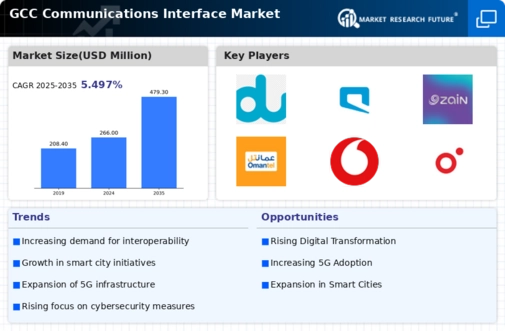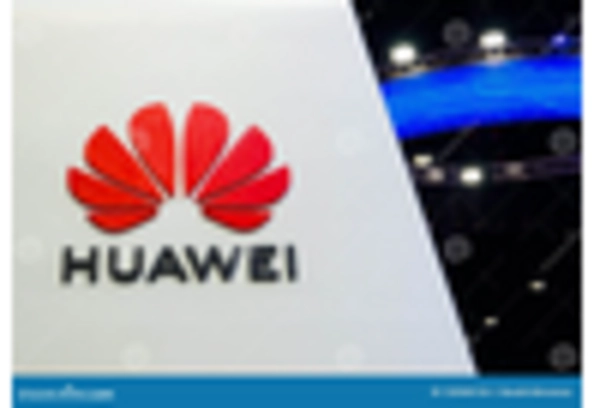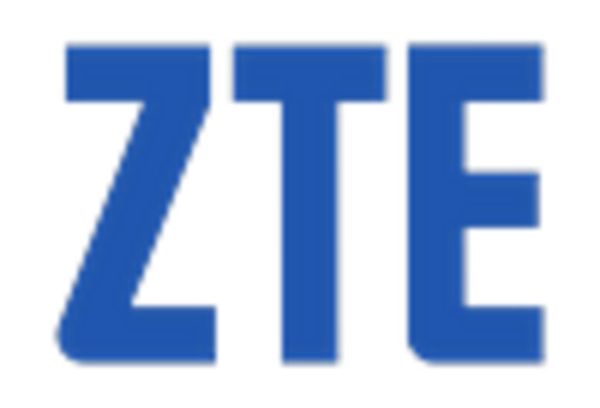Government Initiatives and Regulations
Government initiatives aimed at enhancing digital communication capabilities are significantly influencing the communications interface market in the GCC. Regulatory bodies are implementing policies that promote the adoption of advanced communication technologies, ensuring that businesses comply with international standards. For instance, the GCC governments have allocated over $10 billion for digital transformation projects, which include upgrading communication systems. These initiatives not only stimulate market growth but also encourage private sector investment in innovative communication solutions. Furthermore, the establishment of regulatory frameworks ensures a competitive environment, fostering innovation and improving service quality. As a result, is likely to benefit from these supportive government actions., leading to increased adoption of advanced communication technologies across various industries.
Increased Focus on Data Privacy and Security
The heightened emphasis on data privacy and security is a significant driver for the communications interface market in the GCC. With the rise of digital communication, concerns regarding data breaches and cyber threats have escalated. As a response, businesses are investing in secure communication interfaces that comply with stringent data protection regulations. The market for secure communication solutions is expected to grow by 25% in the coming years, as organizations prioritize safeguarding sensitive information. This focus on security not only enhances consumer trust but also drives innovation in the communications interface market, leading to the development of advanced encryption technologies and secure communication protocols. Consequently, the demand for secure communication solutions is likely to shape the future landscape of the communications interface market.
Advancements in Telecommunications Infrastructure
The ongoing enhancements in telecommunications infrastructure within the GCC region are pivotal for the communications interface market. Investments in 5G technology and fiber-optic networks are expected to reach approximately $20 billion by 2026, facilitating faster and more reliable communication. This infrastructure development not only supports existing communication needs but also enables the integration of advanced technologies such as IoT and AI. As businesses and consumers increasingly demand high-speed connectivity, is likely to experience substantial growth.. Enhanced infrastructure will also support the burgeoning demand for data services, which is projected to increase by 30% annually. Thus, the advancements in telecommunications infrastructure are a critical driver for the communications interface market, fostering innovation and expanding service offerings across various sectors.
Growing Demand for Unified Communication Solutions
The rising demand for unified communication solutions is reshaping the communications interface market in the GCC. Businesses are increasingly seeking integrated platforms that combine voice, video, and messaging services to enhance collaboration and productivity. The market for unified communication solutions is projected to grow at a CAGR of 15% over the next five years, driven by the need for seamless communication in remote and hybrid work environments. This trend is particularly pronounced in sectors such as education, healthcare, and finance, where effective communication is crucial. As organizations recognize the value of unified communication in improving operational efficiency, is likely to expand., offering innovative solutions that cater to diverse business needs.
Emergence of Artificial Intelligence in Communication
The integration of artificial intelligence (AI) into communication systems is emerging as a transformative driver for the communications interface market in the GCC. AI technologies are being utilized to enhance user experiences, streamline communication processes, and provide intelligent insights. For instance, AI-powered chatbots and virtual assistants are increasingly being adopted by businesses to improve customer service and engagement. The market for AI in communication is projected to grow at a CAGR of 20% over the next five years, reflecting the increasing reliance on AI-driven solutions. This trend not only enhances operational efficiency but also fosters innovation within the communications interface market, as companies seek to leverage AI capabilities to differentiate their offerings. As a result, the emergence of AI is likely to play a crucial role in shaping the future of communication technologies.

















Leave a Comment